You only pay 15,00% deposit now
Free cancelation 32+ days before check in
7 Day Yoga, Meditation, Nature: Disconnect and Arise in Fuerteventura
-
Activities
Yoga
Yoga
Yoga
Meditation
Hiking & trekking
-
Minimum no. of participants
4
-
Suitable for
All levels
-
Accommodation
Villa, Eco-resort / property
-
Length of retreat
7 nights
-
Meals included
Breakfast
-
Capacity
up to 6 persons
-
Main instructor language
English
Instructors also speak
Spanish
Welcome to a unique retreat, immersed in the enchanting energy of a volcanic island, a magical place where disconnection becomes a rediscovery of peace and well-being. This retreat is designed to offer you an extraordinary experience, focusing on several key elements that embrace the essence of the island's powerful nature. Here's what you can expect:
🌋 You will be enveloped by the unique energy of this volcanic island, an environment that conveys a sense of natural power and ancient wisdom. Let yourself be enveloped by the telluric force that characterizes this place, rediscovering the connection with the earth and the flow of vital energy.
🌱 In this corner of paradise, disconnection becomes a ritual of renewal. Far from everyday distractions, you will have the opportunity to unplug, abandon your worries and completely immerse yourself in the relaxing atmosphere of the island.
🌿 Through yoga practices guided by expert teachers, you will discover the power of achieving a state of inner peace. Physical wellbeing will be at the heart of the experience, with sessions aimed at releasing tension, improving flexibility and reconnecting mind and body.
🥒 You will nourish your body with healthy foods and have the opportunity to experience detoxification practices, freeing the body from accumulated toxins and allowing a feeling of lightness and vitality.
🕉️ Through in-depth workshops and introspection sessions, you will have the opportunity to fully explore your yoga practice and gain a greater understanding of yourself. This moment of reflection will be guided by experts who will accompany you on your personal growth journey.
🏜️ You will explore the wild beauty of the island, immersing yourself in its volcanic nature. Adventurous trekking and moments of contemplation will be the bridge between your yoga practice and the majesty of the natural elements.
This retreat is more than just a holiday; it is a profound journey towards your total well-being, allowing you to connect with the force of nature, with yourself and with a feeling of newfound peace. Welcome to an experience that goes beyond the surface, embracing the true essence of this wonderful volcanic island.
Yoga
Vinyasa or flow yoga is a type of yoga where a series of postures or asanas are synchronized with the breath; that is, breathing and movement come together. You flow and evolve throughout the practice. Vinyasa is a type of dynamic yoga that makes you move your body with conscious breathing. In fact, some say that it is a moving meditation. VI: place yourself in a certain way (asana or posture). NYASA: meditate by focusing your attention on something specific (breathing). FLOW: to flow. So it could be translated as flow while you move and breathe. The sun salutation, for example, is a type of vinyasa, where the asanas are matched with each inhalation and exhalation; that makes a series of consecutive postures linked by the breath create a fluid movement. Specifically, the sun salutation A has 9 vinyasas or movements). Unlike hatha yoga, in vinyasa or flow yoga the postures are held for less time. Practice It is “a complete method for physical and spiritual development.” This yoga system is mainly characterized by the synchronization of breathing with the movement of the body. Each of the important yoga asanas (postures) is practiced with different and elaborate movements to enter and exit the asanas. In addition, each posture is linked to the next through a dynamic transition harmonized by breathing. All vinyasa yoga practices, both Ashtanga and Power, as well as Flow Yoga or Vinyasa Flow, involve movement from posture to posture, maintaining the continuity of the breath. In the words of Srivatsa Ramaswami: “The mind attentively follows the slow, smooth and controlled breath, and the union of the body and mind takes place with the act of breathing as a harness.” Ultimately, what is vinyasa yoga? Well, a system of synchronized movements and breathing, a yoga method in which the postures are chained in an intelligent sequence that seeks to achieve benefits both physically, mentally, emotionally and spiritually. What is Vinyasa Yoga good for? Vinyasa practice has different benefits: Physically, it improves flexibility at the muscular level and favors its strengthening and toning. It also helps make bones stronger. Due to this fluidity of movement with breathing, it helps us to improve breathing, relieving respiratory problems such as asthma, allergies… Mentally, it decreases stress levels, bad mood… promoting relaxation. It also helps to fall asleep. Practicing vinyasa, and yoga in general, you will know what your limits are, you will give value to the things you have and you will be happier.
- Vinyasa Yoga
Yoga
The word hatha is made up of two words, ha and tha. The word ‘ha’ means Sun and ‘tha’ means Moon. Together, the word means to create a balance between the sun and the moon energies present in an individual. The aim of this Yoga style is creating a harmony between the solar (Pingala) and lunar (Ida) energies within us so as to help us to achieve a higher consciousness in life. It is the science of initializing the central Nadi, Sushumna which leads to the path of enlightenment. Practice The practice of hatha yoga comprises of elements related to both behavior and practice. As per the hatha yoga texts, a yogi has to possess certain characteristics in order to become successful. Those characteristics involve enthusiasm (utsaha), courage (sahasa), patience (dhairya), essence of knowledge (jnana tattva), resolve (nishcaya) and soºlitude (tyaga). When talking about the western culture, hatha yoga is mainly about the asanas. But in India, it goes beyond being just an exercise system and integrates other aspects such as diet, cleansing, ethics, meditation, pranayama, etc. a part of it. What is a Hatha Yoga class like? Hatha and Hatha Yoga are used in modern times as a broad and generic term for yoga which does not have a specific style attached to it. A typical class will be relatively gentle, slow and good for beginners, but it is difficult to know what a specific class will be like before attending. This practice typically starts with some gentle warm-ups, continues to a sequence of poses, and end with 5-10 minutes of relaxation in corpse pose. A class will often begin and end with a short seated meditation. The class often concludes with students bringing their hands together in prayer position while bowing and saying Namaste. Hatha classes are usually 60 to 90 minutes long and may also include pranayama breathing exercises as a separate practice or integrated with the yoga postures. What is Hatha Yoga good for? Hatha Yoga is usually taught as a householder path with a focus on the physical attainment of the poses. Hatha practices are designed to align, cleanse and calm your body, mind, and spirit in order to achieve deeper states of meditation and spiritual realization. A regular practice can improve strength, stamina, flexibility, range of motion, and balance; reduce stress; promote mental calm; and provide many other therapeutic benefits as well. The many different styles or schools of Hatha Yoga have more specific benefits.
- Hatha Yoga
Yoga
Yin yoga is the perfect complement to yang. These types of yoga are adapted to each other with a final purpose, to balance body and mind through our two dualities: the internal, feminine, dark and passive energy, and the external, masculine, more luminous and active energy. Both inhabit everything that surrounds us and both existences need the other to be. Yin and yang are concepts that derive from Taoist philosophy. In this way we can distinguish between yang yoga practices, more dynamic or active, such as vinyasa yoga, hatha yoga, power yoga… And yin classes, with a much slower and more passive rhythm. Practice Yin yoga is a slow practice of asanas, whose postures are normally performed on the floor, and are held passively for a period of time between approximately 2 and 5 minutes, thus achieving a broad stretch, calming our mind and our body. Thanks to this delicate practice we can achieve pleasant sensations of well-being, perfect for disconnecting, enjoying and relaxing. It is about maintaining stillness and moving slowly between posture and posture. This is not to say that yin practice is effortless. It is really difficult to maintain yoga postures for so long. It is gravity that acts on our body, and stretching manages to reach the deepest layers thanks to the passive activation of connective tissues.The energy channels of the meridians, nerves and the blood system are also worked on, which you may know if you are familiar with traditional Chinese medicine or acupuncture. What is a Yin Yoga class like? In Yin Yoga, we hold most poses between 5 and 10 minutes. This is in contrast to the dynamic forms like Ashtanga Vinyasa and Vinyasa Flow, where the poses are held for 5 to 10 breaths, and we constantly move in and out of the poses. Even though Hatha Yoga is much more static, most poses (for beginners) are held up to a maximum of 3 minutes. So, in Hatha Yoga, too, we usually do not hold the poses as long as in Yin Yoga. When we hold a pose for a longer period, we bring the stretch to the yin tissues, which are the deeper tissues such as the tendons, fascia, ligaments, and the other connective body tissues. Our yin tissues are less vascular (supplied with blood) and less elastic, and therefore need more time to stretch. When stretched regularly, it increases the overall flexibility, circulation, and range of motion in the joints and ligaments. In dynamic styles, such as Vinyasa Yoga, and modern Hatha Yoga, the movement makes the muscles take the main load and stretch. Muscles are yang tissues; they are quick to warm up and stretch but also quick to cool down and rebound. That is why, if you do not practice for a few days, you see a big decline in flexibility and strength. So, if you practice only dynamic forms of exercise or yoga, you will gain muscle strength, but not necessarily a wider range of motion. To have a healthy range of motion around our joints, many of us need to also stretch the deep connective tissue and the joints. According to Paul, Yin Yoga is a complementary practice, not a substitute for the more yang exercises. What is Yin Yoga good for? Not only does it help us to passively gain flexibility by holding the asanas, but it also acts as a meditation thanks to slow and conscious breathing during them. We will be able to find a space of peace in practice, recover mobility and prevent injuries derived from other sports disciplines, since it is one of the styles of yoga that will significantly increase our range of mobility. It is a restorative yoga that will allow us to end the session with a feeling of joy and well-being. It is essential not to feel “pain” during the practice, although it is normal to have some “discomfort” at first. It can also happen that certain sensations arise in a yin session, not only physical but emotional, my recommendation is to let them flow, if you feel like crying, smiling, sighing… let them continue their process while you breathe and loosen up without judging yourself, at the end you will see How do you feel great relief? Sometimes yin yoga allows us to lighten “backpacks” that we carried with us without realizing it. It is a safe practice that respects the anatomy of each yogi and can be done at any age and in any physical condition, since the asanas are adapted to each practitioner with the use of blocks, belts, bolsters, blankets, and other supports. Passively increases flexibility. – Relaxes the central nervous system by working stillness and calm in the postures. – It counteracts the active and dynamic lifestyle of our day to day, the perfect complement to the more active practice of yoga or highly active sports, and we can resort to it in times of fatigue or stress. – It works on the fascias, mobilizing them delicately while achieving a wide range of movement, and with it bodily, mental and emotional opening, as well as general well-being as if you had just received a massage. – It relaxes tensions, loosens up and allows you to be in the here and now as it is a regenerative practice with minimal muscular effort. – It mobilizes prana or vital energy and this has a positive impact on our body, organs and tissues. – Helps concentration and body awareness. – It favors self-practice, since being passive and long-lasting postures, we can repeat them without the need for a teacher to guide us. The benefits can be perceived from the first practice and surely at this point you are wanting to try…
- Yin Yoga
Meditation
Meditation has been practiced for thousands of years. Originally the purpose of meditation was to help deepen one’s understanding of the sacred and mystical forces in life. Today, meditation is commonly used for relaxation and stress reduction and can actually produce a state of deep relaxation and a calm mind. During meditation, you focus your attention and eliminate the flow of confusing thoughts that may be filling your mind and causing you stress. This process can result in an enhancement of physical and emotional well-being. The benefits of meditation Meditation can give you a sense of calm, peace, and balance that can benefit both your emotional well-being and your general health. You can also use it to relax and deal with stress by focusing your attention on something that calms you down. Meditation can help you learn to stay centered and maintain inner peace. These benefits do not end when the meditation session ends. Meditation can help you go through the day more calmly and manage the symptoms of certain medical conditions. Physical and emotional well-being When you meditate, you can clear the information overload that builds up every day and contributes to your stress. The emotional and physical benefits of meditation include: Have a new perspective on stressful situations. Acquire stress management skills Increase self-awareness Focus on the present Reduce negative emotions Increase imagination and creativity Increase patience and tolerance Lower heart rate Lower blood pressure at rest Improve sleep quality Meditation and diseases Anxiety Asthma Cancer Chronic pain Depression Heart disease Arterial hypertension Irritable bowel syndrome Sleeping problems Tension headaches Be sure to talk to your health care provider about the pros and cons of using meditation if you have any of these conditions or other health problems. In some rare cases, meditation could worsen symptoms associated with certain mental health conditions. The ways to meditate can be: Meditation is a general term for the many ways to achieve a state of relaxation. There are many types of meditation and relaxation techniques that have meditative components. They all share the same goal of achieving inner peace Guided Meditation. It is sometimes called guided imagery or visualization; With this method of meditation you form mental images of places or situations that relax you. Try to use as many senses as possible, such as smells, visual images, sounds, and textures. A guide or teacher can lead you through this process. Meditation with mantra. In this type of meditation, you silently repeat a calming word, thought, or phrase to avoid distracting thoughts. Mindfulness meditation. This type of meditation is based on being attentive or having a greater awareness and acceptance of living in the present moment. In mindfulness meditation, you expand your conscious awareness. You focus on what you feel during meditation, such as the flow of your breath. You can observe your thoughts and emotions, but you must let them pass without judging them. Qigong. This practice usually combines meditation, relaxation, physical movement, and breathing exercises to restore and maintain balance. Qi gong is part of traditional Chinese medicine. Tai Chi. It is a form of training in a soft Chinese martial art. In tai chi you do a series of postures or movements at your own pace and in a slow and graceful manner while practicing deep breathing. Transcendental Meditation. Transcendental meditation is a simple and natural technique. In this form of meditation, you silently repeat a certain mantra, such as a word, sound, or phrase, in a specific way. This form of meditation may allow your body to enter a state of deep rest and relaxation, and allow your mind to achieve a state of inner peace without worry, without needing to concentrate or exert yourself. Yoga. You do a series of postures and controlled breathing exercises that stimulate the flexibility of the body and mental calm. By performing poses that require balance and concentration, you are encouraged to focus less on your busy day and more on the moment. Elements of meditation The various types of meditation may include different elements to help you meditate. These can vary depending on who guides you or who teaches the class. Some of the more common elements in meditation include: Focus attention. Focusing attention is generally one of the most important elements of meditation. It is what helps free your mind from the many distractions that cause stress and worry. You can focus your attention on things like a specific object, an image, a mantra, or even your breath. Relaxed breathing. This technique involves deep, even breathing, using the diaphragm muscle to expand the lungs. The purpose is to slow your breathing, take in more oxygen, and reduce the use of the muscles in your shoulders, neck, and upper chest when breathing, in order to breathe more efficiently. A quiet place. If you are a beginner, practicing meditation will be easier if you are in a quiet place with few distractions, including no TV, radio, or cell phone. With more experience with meditation, you may be able to meditate anywhere, especially in high-stress situations when you will benefit most from meditating, such as in a traffic jam, in a stressful work meeting, or waiting in a long line at the Supermarket. A comfortable position. You can practice meditation sitting, lying down, walking, in other positions, or during activities. Just try to be comfortable so that you can get the most out of your meditation. Try to maintain good posture during meditation. Open attitude. Allow thoughts to pass through your mind without judging them.
view moreHiking & trekking
Montana sagrada de Tindaya One of the most emblematic places in the Canary Islands is located on the island of Fuerteventura and is called Montaña Tindaya, a place where the ancient maho built the order of the world and the cosmos. The universe reduced to a mountain and, therefore, the study of the peaks and the ruins found on them becomes essential to understanding many aspects of their beliefs. The geostrategic position that Mount Tindaya occupies is doubly unbeatable both for the observation of the sky and for the correlation of the stars. Now, what profound meaning do the more than 200 footprints carved into the rock on the south face of Montaña Tindaya hide? What do they symbolize?... Calderon Hondo One of the best places on the island to see such spectacular scenery is from the Calderón Hondo volcano, located near the town of Lajares. Only from there can you admire the line of volcanoes that extended the island of Fuerteventura to the north, eventually forming the island of Lobos. It is easy to imagine the intense volcanic activity in the area. The seven volcanic cones 4.5 km long. in the formation known as Bayuyo they are formidable. Calderón Hondo is one of the seven volcanoes of Bayuyo that has the best state of preservation. Reaching it is easy, climb up and even look into its crater. From its summit, 278 meters above sea level and on the edge, you can admire a large crater 70 meters deep as well as some very beautiful views of Fuerteventura. Playa Palomitas Popularly known as the popcorn beach, it is synonymous with one of the most remarkable natural spectacles of the Majorera coast. In the coastal strip between El Cotillo and Corralejo we find some peculiar landscapes that until now had remained intact against human pressure and which constitute another of the natural values to be seen in this Biosphere Reserve island. It's quite famous as a site but we will visit it and go to a very authentic bar/restaurant. Molina de la Asomada The mill is a building type unique to Fuerteventura and Venezuela, and at the moment La Asomada is the only mill in Europe in operation powered by the wind and with its wood-fired gofio roaster and white earth. Declared a Site of Cultural Interest, La Molina de La Asomada is located on the route of the Fuerteventura Technology Park. Built in 1818, it was restored by the Government of the Canary Islands and the Council of the Island of Fuerteventura in September 2011. These mills were designed for grinding gofio. Its machinery allows it to produce large quantities of gofio in a short time and to grind different types of flour, since the stone, unlike other mills, turns three times faster and reaches high speeds. *gofio: it is a flour obtained by grinding different types of wheat. The ease of obtaining this typically Canarian product made its consumption habitual in periods of food scarcity.
view moreDay 1
Presentation
Hatha Yoga / Vinyasa flow Practice
Breakfast
Lunch
Free Time
Yin Yoga Practice
Dinner
Day 2
Hatha Yoga / Vinyasa flow Practice
Breakfast
Montaña Tindaya or Calderon Hondo trekking excursion
Packed lunch
Eco-sustainable activity for the Biosphere Reserve
*Optional Chakra dance introduction and lesson
Yin Yoga Practice
Dinner
Free time
Day 3
Vinyasa Yoga / Vinyasa flow Practice
Breakfast
Surf lesson
Packed lunch
Free time
Yin Yoga Practice
Dinner
Free time
Day 4
Hatha Yoga / Vinyasa flow Practice
Breakfast
Free Time
Lunch
Free time
Yin Yoga Practice
Dinner
Day 5
*Optional day in Isla de Lobos
Vinyasa Yoga / Vinyasa flow Practice
Breakfast
Lunch and free time
Yin Yoga and Meditation Practice at sunset on the beach
Dinner
Free Time
Day 6
Hatha Yoga / Vinyasa flow Practice
Breakfast
Free time
Lunch
Free time
Breath and Meditation Practice
Vegetarian Barbecue
Free time to share together
Day 7
Hatha Yoga / Vinyasa flow Practice
Breakfast
Free time
Lunch
* Optional: Workshop "What are the 7 Chakras and how to keep them in
balance"
Lajares
A privileged environment full of peace between Corralejo and El Cotillo
In one place on the island... two old mills reign, silence and tranquility. This is Lajares, a town full of peace in a privileged environment between two of the most attractive points in the north of Fuerteventura: El Cotillo, with some of the best surf spots on the island, and Corralejo, for those who, in addition to sports or relaxation, More absolutely, they want to enjoy the hustle and bustle of the most lively area of the island.
In Lajares the past and present integrate perfectly. And the fact is that the population that has formed little by little between “natives” and surf lovers coming from all the destinations in Europe is curious. Among its streets you will find traditional Canarian craft shops where Majorera women still make typical Canarian lace and embroidery today, an important variety of businesses dedicated to surfing, shops, repair workshops and high-quality schools.
But, in addition, over its mills, its Church and its white houses, a black volcano also reigns that gives it a certain air of mystery. It is the Calderón Hondo volcano, where an interesting route begins that ends in Corralejo. Due to the volcanic past of the island and this area in particular, known as Malpaís de Mascona, the wind and the earth have shaped a spectacular landscape over the basaltic lava over time, creating enigmatic landscapes such as the Enchanted Caldera. that is worth knowing.
In short, Lajares is a special haven in the north of Fuerteventura where its contrasts, its simple beauty and its immense tranquility will make you feel that you are in the perfect destination.
How to get there
Take FV-2.
56s (550m)
Continue by FV-2. Drive from FV-1 to La Oliva. Return to climb 28 from FV-1
23 min (28.4 km)
Take FV-109 towards C. la Cancela in Lajares.
Airport
Aeropuerto de Fuerteventura - 33 km
Villa, Eco-resort / property
Da Mata Kite&Surf House is located in Lajares and features garden views, a fitness center, a garden, a common lounge, a terrace and barbecue facilities. Free WiFi is offered throughout the property.
There is a fully equipped private bathroom with a shower and a hairdryer.
You can practice cycling in the surroundings.
Our Villa is composed by 3 bedrooms (2 single and 1 shared), each one with private bathroom, a big open space with the kitchen, a garden and a wonderful terrace with a Relax zone.
We left Turin in order to follow our passion: Kitesurf, and we have chosen Fuerteventura because it is the perfect island if you are looking for wind and waves! With our Surfhouse we created a place where people can share our passions for Nature, Sea, Wind and above all Sports.
We have chosen Lajares because of its position between Corralejo and Cotillo and right in front of Majanicho and the North Shore.
Alcibiades Ecomuseum is 23 km from the accommodation, and Unamuno House Museum (Fuerteventura) is 29 km away. The nearest airport (Fuerteventura Airport) is 33 km from the accommodation.
- Garden
- Fully equipped kitchen
- Free wifi
- Tours and daytrips
- Outdoor terrace
- Outdoor exercise possibilities
- Air conditioning
- Washing machine
- Surfboard and SUP rental
- Restaurant nearby
Delicious and fresh breakfast will be provided every morning.Our holidays are self-catering: we encourage our guests to go out and try out amazing cafes and restaurants with diverse offers. We strongly believe that eating out and trying out local cuisine is an experience on its own and a must when visiting this island. We provide our guests with a local guide to the best restaurants and cafes in town.
- Breakfast
- Coffee
- Water
- Tea
- Breakfast and tea, coffes, infusions, water
- 7 days shared bungalow villa accomodation
- 2 daily Yoga practices
- Montana Sagrada or Calderon Hondo trekking excursion
- Surf class
- Eco-sustainable activity for the Biosphere Reserve
- Shared car for the week
- Professional Photographer
- Insurance Coverage During Sports Activities
- Flights
- Optional day Lobos island (authorization and ferry included)
- Optional Workshop "What are the 7 Chakras and ho how to keep them in balance"
- Optional introduction and chakra dance lesson
Free cancelation 32+ days before check in
Guests will incur a fee 50% if they cancel their booking 6-15 days before check-in
Guests will incur a fee 100% if they cancel their booking 0-5 days before check-in



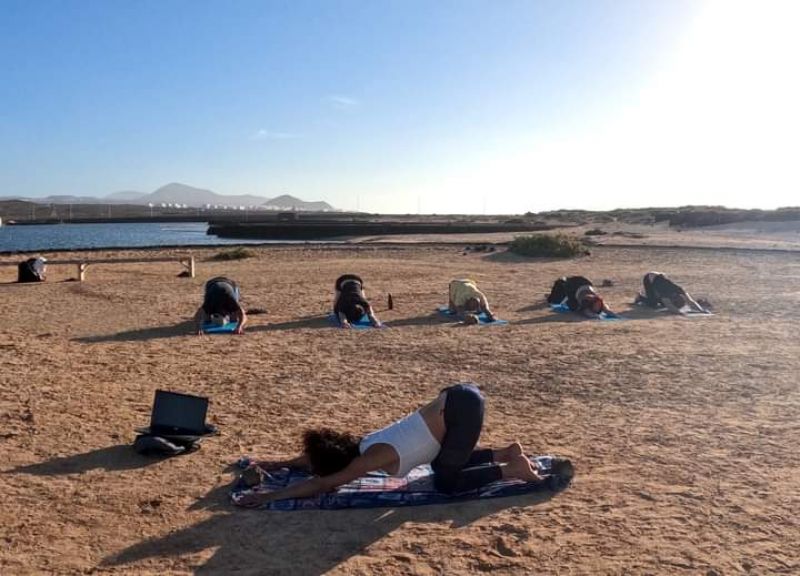
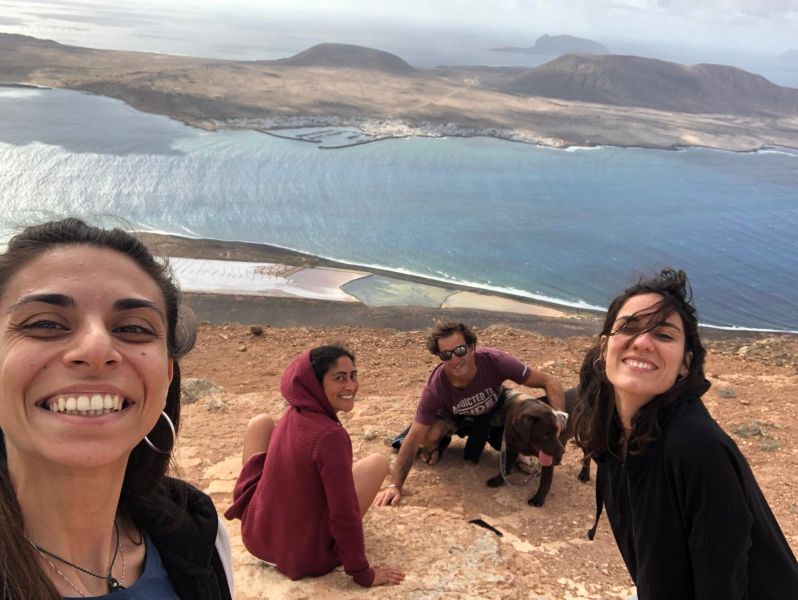




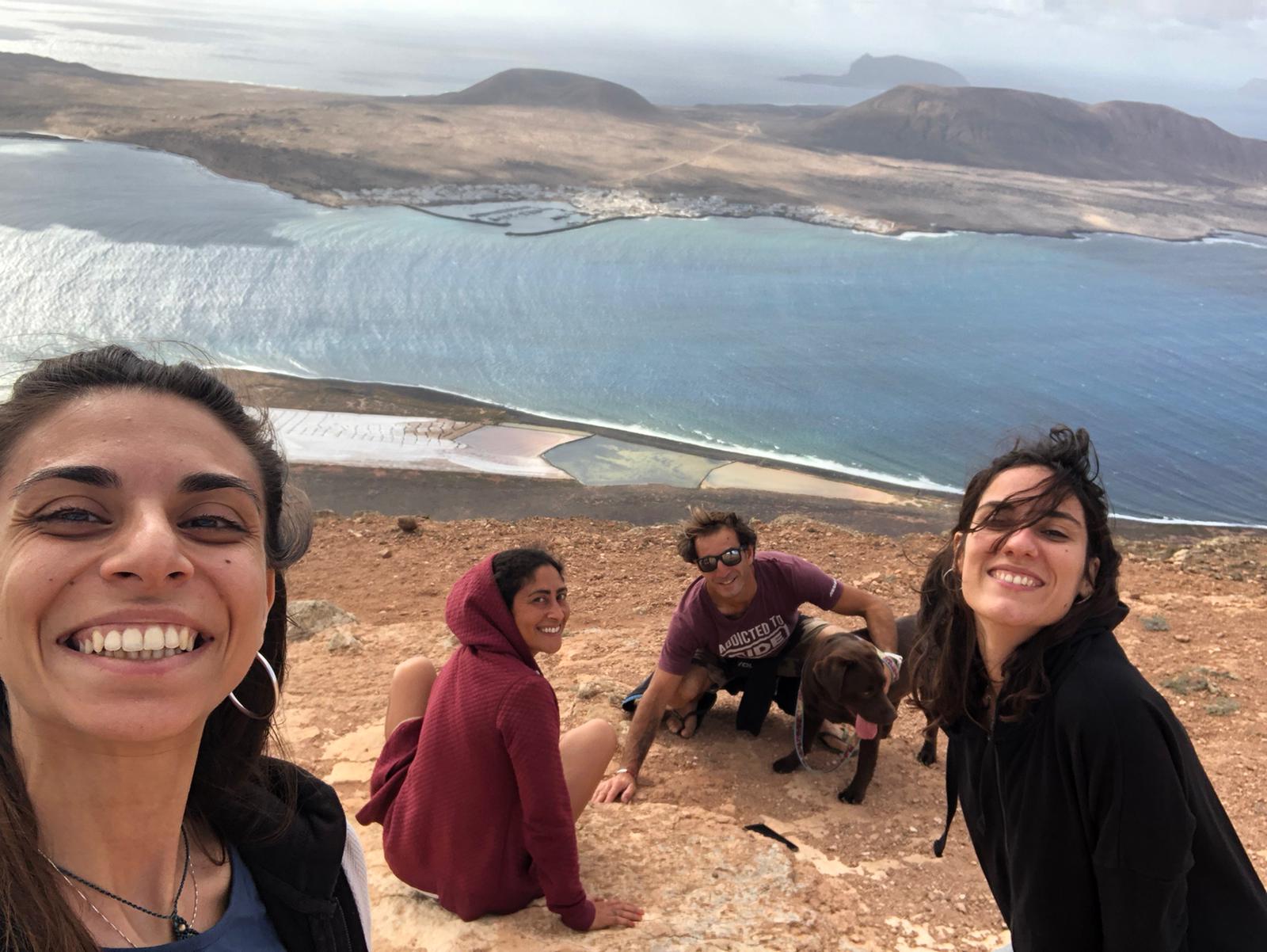
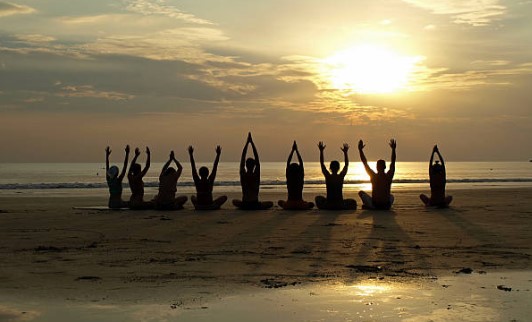








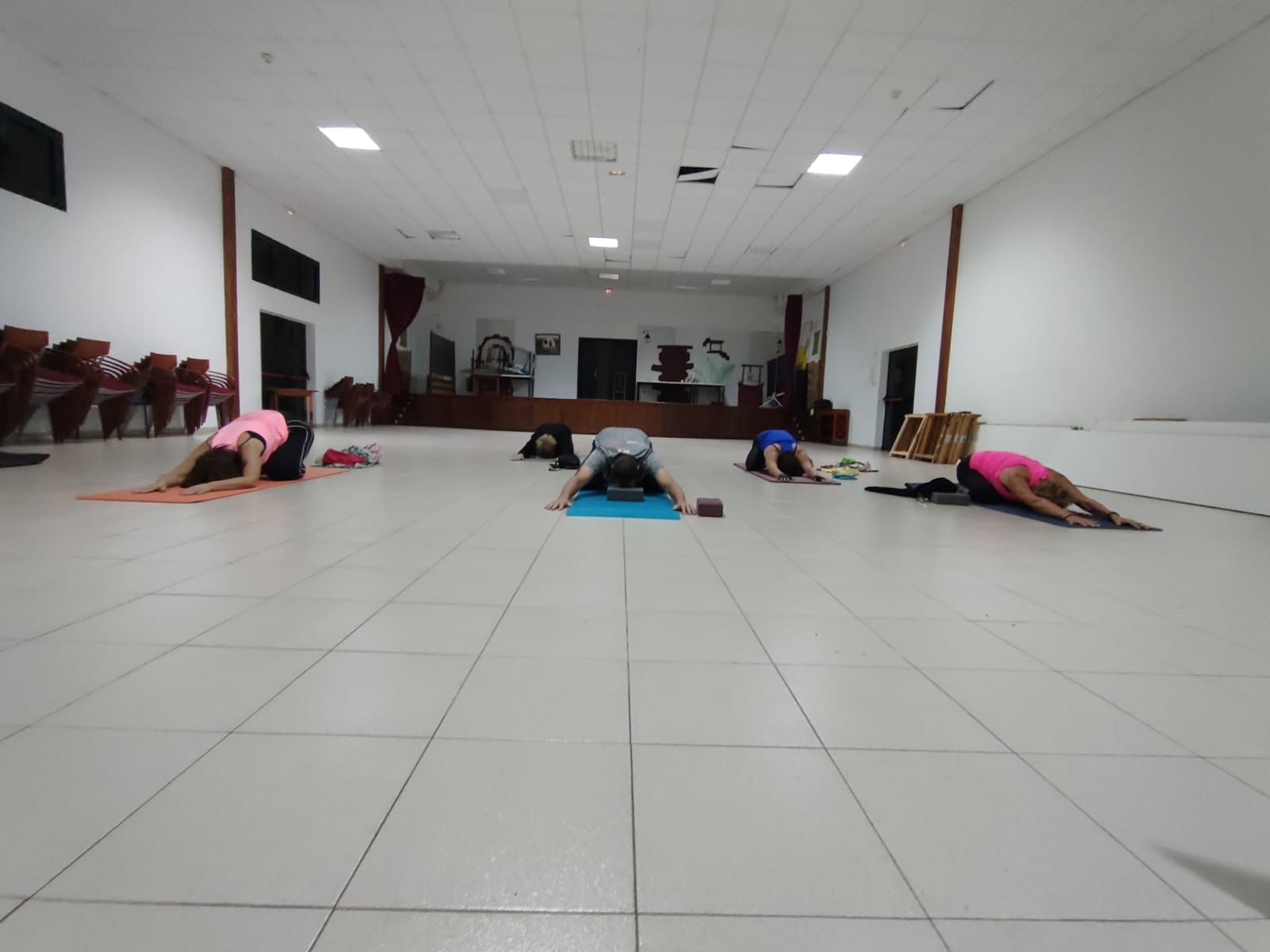

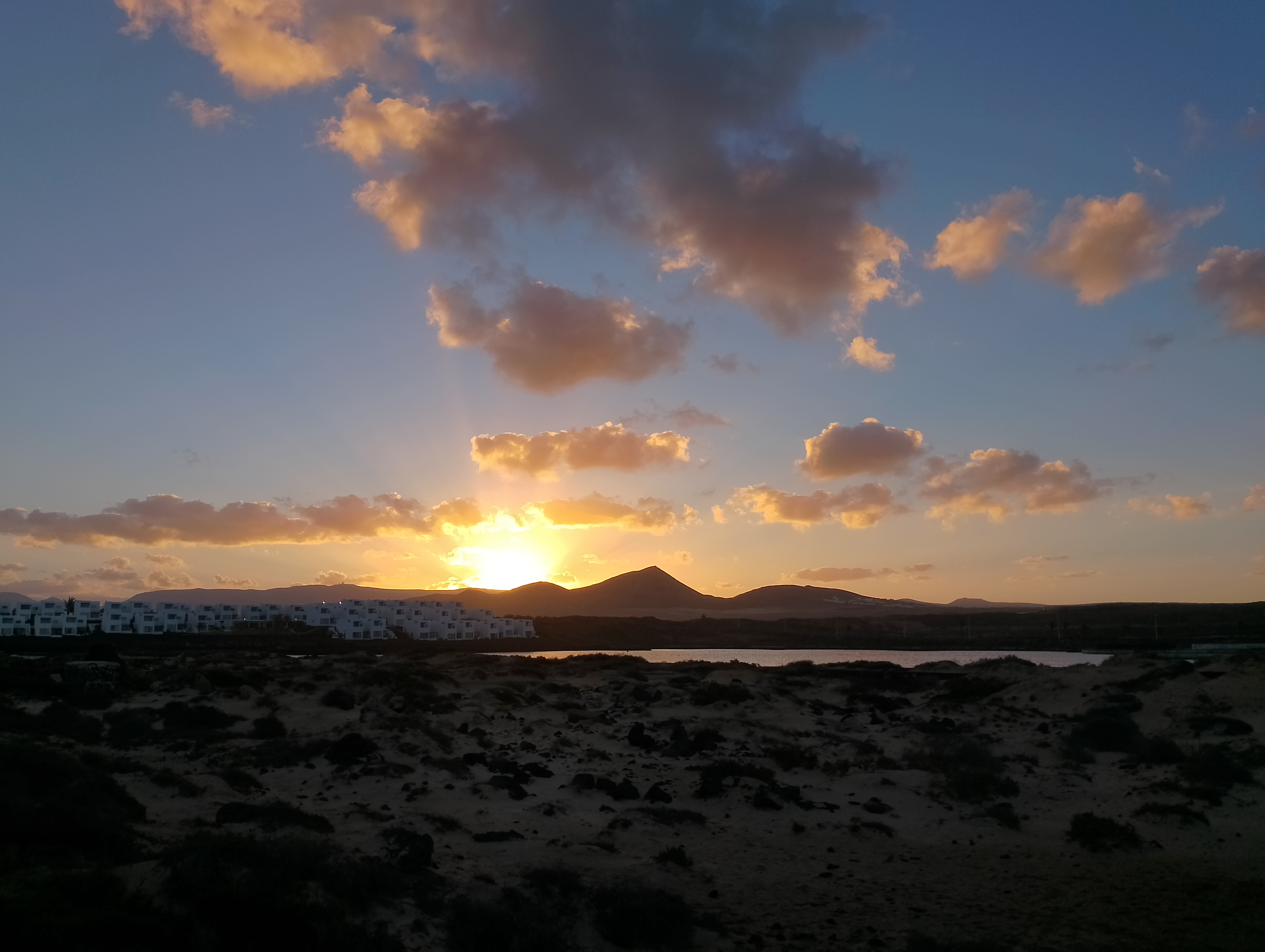



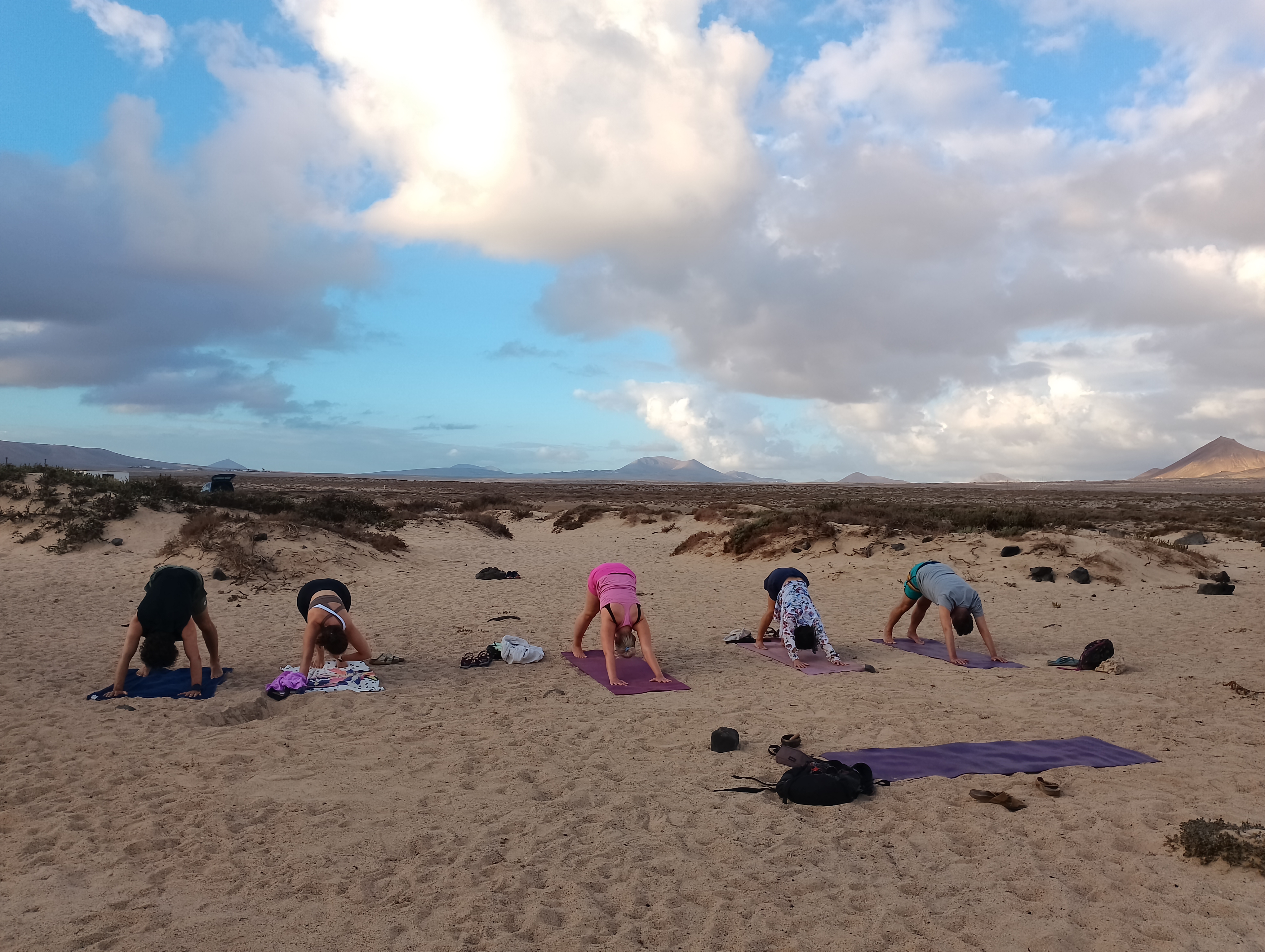
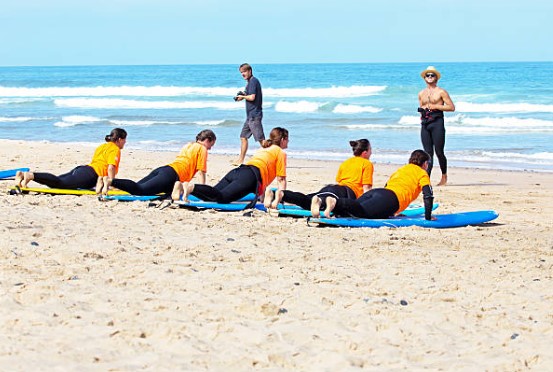















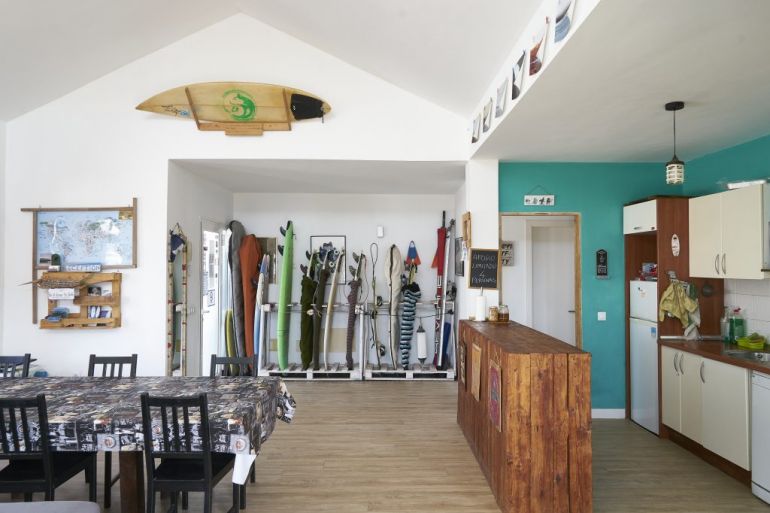

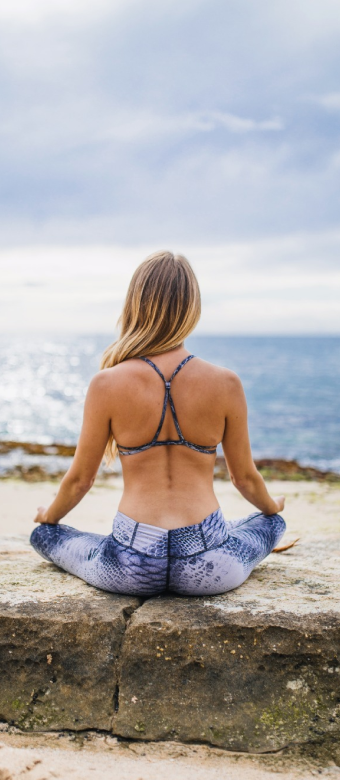
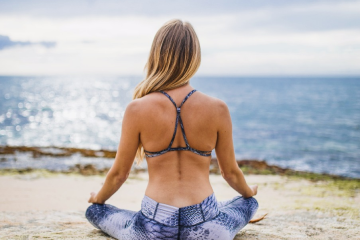

Ivana
Instructor
My name is Ivana and with several years of experience as a yoga teacher, I am able to manage a large number of classes, and I can customize my classes according to the preparation of the students and their aptitudes. Furthermore, I adapt to every need, I am full of resources, and I manage to have excellent interpersonal relationships with my students.
Yoga
Even before I certified myself as a yoga teacher, I started my career collaborating with schools, centers and many other realities on the island of Lanzarote, where I have lived in recent years. I mainly dealt with the organization of yoga courses and lessons for beginners and experts. I consider myself a sensitive and empathetic person. I believe I have excellent communication and interpersonal skills.